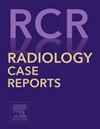与Chiari - 1型畸形相关的脊髓积水、脊髓畸形和脊髓畸形1例报告
Q4 Medicine
引用次数: 0
摘要
脊髓脊髓积水、脊髓球畸形和脊髓头畸形是Chiari-I畸形(CM-I)的罕见表现,均由脑脊液动力学紊乱引起。虽然脊髓空洞通常与cm - 1相关,但鼻窦腔向脑干(脊髓球)和脑实质(脊髓头畸形)的吻侧延伸非常罕见,全球报道的病例有限。本病例报告描述了一名40岁女性,表现为进行性神经功能障碍,包括偏瘫、感觉障碍和球症状。磁共振成像显示cm - 1伴脊髓积水腔,从颈髓交界处延伸至胸脊髓,脊髓积水累及脑干,脊髓积水影响左脑半球、内囊和基底节区。在后颅窝减压后,患者的神经系统得到了显著的改善,包括运动功能的恢复和颅内水肿的消退,尽管颈喉腔保持稳定。该病例显示了早期诊断和手术干预在治疗这些罕见但使人衰弱的CM-I并发症中的重要性,强调了尽管这些病变的复杂性和广泛性,但改善预后的潜力。本文章由计算机程序翻译,如有差异,请以英文原文为准。
Syringohydromyelia, syringobulbia and syringocephaly associated with Chiari – I malformation: A case report
Syringohydromyelia, syringobulbia, and syringocephaly are rare manifestations of Chiari-I malformation (CM-I), each resulting from disrupted cerebrospinal fluid dynamics. While syringomyelia is commonly associated with CM-I, the rostral extension of syrinx cavities into the brainstem (syringobulbia) and cerebral parenchyma (syringocephaly) is very rare, with limited cases reported globally. This case report describes a 40-year-old woman presenting with progressive neurological deficits, including hemiparesis, sensory disturbances, and bulbar symptoms. Magnetic resonance imaging revealed CM-I with a syringohydromyelic cavity extending from the cervicomedullary junction to the thoracic spinal cord, syringobulbia involving the brainstem, and syringocephaly affecting the left cerebral hemisphere, internal capsule, and basal ganglia. Following posterior fossa decompression, the patient experienced significant neurological improvement, including restored motor function and resolution of intracranial edema, although the cervical syrinx cavity remained stable. This case demonstrates the importance of early diagnosis and surgical intervention in managing these rare yet debilitating complications of CM-I, highlighting the potential for improved outcomes despite the complex and extensive nature of these lesions.
求助全文
通过发布文献求助,成功后即可免费获取论文全文。
去求助
来源期刊

Radiology Case Reports
Medicine-Radiology, Nuclear Medicine and Imaging
CiteScore
1.10
自引率
0.00%
发文量
1074
审稿时长
30 days
期刊介绍:
The content of this journal is exclusively case reports that feature diagnostic imaging. Categories in which case reports can be placed include the musculoskeletal system, spine, central nervous system, head and neck, cardiovascular, chest, gastrointestinal, genitourinary, multisystem, pediatric, emergency, women''s imaging, oncologic, normal variants, medical devices, foreign bodies, interventional radiology, nuclear medicine, molecular imaging, ultrasonography, imaging artifacts, forensic, anthropological, and medical-legal. Articles must be well-documented and include a review of the appropriate literature.
 求助内容:
求助内容: 应助结果提醒方式:
应助结果提醒方式:


